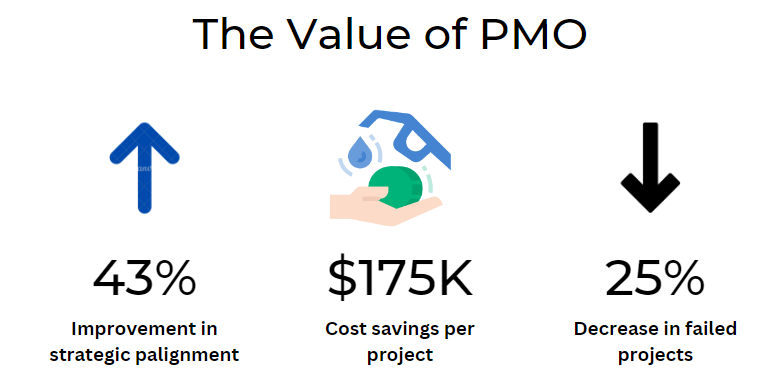
Introduction
Having a project management office (PMO) within an organization can improve the efficiency and consistency of project delivery through the development of standard practices and methodologies. In addition, the PMO serves as a central hub for all projects and supports project teams. This article will provide an overview of the PMO and outline the benefits of having one for those involved in project management.
Table of Contents:
- Introduction
- What is Project Management Office?
- What is the Purpose of a Project Management Office?
- Benefits of Project Management Office
- What Added Value Does a PMO Provide?
- PMO Roles and Responsibilities
- PMO in Project Management
- Conclusion
What is Project Management Office?
A Project Management Office (PMO) is a centralized department within an organization that is responsible for the standardization, oversight, and coordination of project management practices. The primary goal of a PMO is to improve the overall success rate of projects within an organization. PMOs can take on various forms, including providing support and guidance to project managers, implementing and enforcing project management methodologies, and managing the organization’s portfolio.
The specific responsibilities of a PMO can vary depending on the needs and goals of the organization. In some cases, a PMO may be responsible for establishing and enforcing project management standards and processes, providing training and support to project managers, and overseeing the performance of project teams. In other cases, a PMO may be more focused on managing the organization’s portfolio of projects, including prioritizing projects, allocating resources, and monitoring the progress of ongoing projects. Regardless of its specific focus, the ultimate goal of a PMO is to improve the efficiency and effectiveness of project management within an organization.
What is the Purpose of a Project Management Office?
A Project Management Office (PMO) aims to establish, implement, and effectively manage project management standards, processes, and procedures. The PMO provides project teams with the guidance and support they need to ensure projects are completed on time and within budget. Additionally, a PMO can provide a central point of contact for project stakeholders and help ensure all projects are aligned with the organization’s overall strategy and objectives.
Benefits of Project Management Office
A Project Management Office (PMO) is a centralized department within an organization that is responsible for the standardization, oversight, and coordination of project management practices. PMOs can take on various forms, including providing support and guidance to project managers, implementing and enforcing project management methodologies, and managing the organization’s portfolio.
There are many benefits to having a PMO within an organization, including the following:
-
Improves Project Delivery
A PMO can help ensure that projects are completed on time, within budget, and to the required quality standards. This is achieved through implementing standard processes and project management tools and techniques, such as risk management and change control.
For example, a PMO can establish a standardized project management methodology that outlines the steps required to complete a project from start to finish. This methodology can include project planning, execution, monitoring and controlling, and closing. By following this methodology, project teams can be more efficient and effective in delivering projects on time and within budget.
A PMO can help implement tools and techniques such as risk management and change control to identify and mitigate potential risks to a project. For example, a PMO can help project teams identify potential risks, assess their likelihood and impact, and develop strategies to mitigate or eliminate them. As a result, a PMO can help ensure projects are delivered successfully by proactively managing risks.
-
Enhanced Coordination and Communication
A PMO can facilitate communication and coordination between project teams, departments, and stakeholders. This can be particularly important in organizations with complex or multi-faceted projects.
For example, a PMO can establish a centralized project management system that allows all stakeholders to access project-related information and communicate in real-time. This can reduce misunderstandings and improve the flow of information between project teams, ultimately leading to more successful project delivery.
A PMO can help facilitate regular meetings and communications between project stakeholders to ensure that everyone is on the same page and that any issues or concerns are addressed promptly.
-
Greater Visibility and Control
A PMO can provide greater visibility and control over the organization’s portfolio of projects, enabling decision-makers to decide which projects to prioritize and allocate resources to.
For example, a PMO can establish a project management dashboard that provides real-time data on the status of all ongoing projects. This dashboard can include project progress, budget, and resource utilization. This readily available information lets decision-makers decide which projects to prioritize and allocate resources to.
A PMO can help establish a project governance framework that outlines the roles and responsibilities of all stakeholders involved in a project and the decision-making process for approving or rejecting changes to a project. This can help ensure that projects are being delivered in a consistent and controlled manner.
-
Increased Efficiency and Productivity
A PMO can help increase efficiency and productivity within the organization by standardizing project management practices and supporting project teams. This can ultimately lead to cost savings and increased competitiveness.
For example, a PMO can help streamline project management by providing project teams with templates, tools, and training. This can reduce the time and effort required to complete projects, allowing teams to be more productive and efficient.
In addition, a PMO can help identify and eliminate bottlenecks or inefficiencies in the project management process, helping to improve the organization’s overall efficiency.
-
Improved Risk Management
A PMO can help identify and mitigate potential project risks through risk assessment, management tools, and techniques.
For example, a PMO can establish a risk register that outlines all potential risks to a project, along with the likelihood and impact of each risk. The PMO can help project teams develop strategies to mitigate or eliminate these risks, such as implementing contingency plans or allocating additional resources to high-risk areas.
-
Enhanced Career Development Opportunities
A PMO can provide opportunities for project managers and other team members to learn and develop new skills, enhancing their career prospects and contributing to the organization’s overall success.
For example, a PMO can offer training and development programs to help project managers and other team members learn new project management techniques and tools. This can help employees stay up-to-date with industry practices and improve their overall project management skills.
In addition, a PMO can provide opportunities for team members to work on various projects, allowing them to gain experience in different industries and business areas. This can help employees develop a diverse set of skills and experiences that can be beneficial to their careers.
-
Greater Consistency
A PMO can ensure that projects are delivered consistently, which is particularly important in organizations with multiple projects or those operating in regulated industries.
For example, a PMO can establish standard templates and processes for project planning, execution, monitoring and controlling, and closing. Project teams can use these standardized templates and processes to deliver projects more consistently.
In addition, a PMO can ensure that all projects follow the same risk management and change control processes, which helps reduce the likelihood of errors or unexpected issues arising during the project lifecycle. This can be particularly important in regulated industries where the consequences of mistakes or deviations from established processes can be severe.
-
Proving Business Value
To ensure the success and continued existence of your project management office (PMO), it is important to increase awareness among stakeholders of the value of your PMO and project portfolio management (PPM) process.
By proactively protecting the most important projects and making strategic decisions that allow for flexibility and resource management, you can effectively demonstrate your PMO’s value through automated tracking, dashboards, and customizable reporting that show the return on investment of your actions.
In addition, your PMO will be able to prove its worth to the business through metrics and data, highlighting its strategic value to stakeholders. The below graphic further illustrates the importance of office project management.
What Added Value Does a PMO Provide?
A Project Management Office is an organizational structure designed to help facilitate successful project delivery. It provides a centralized point of contact for managing multiple projects and resources and provides the necessary resources and tools to ensure that projects are delivered on time and within budget. In addition, a PMO can provide several added values to an organization, such as increased efficiency and coordination, improved collaboration, and more effective use of resources.
The office project management will also provide governance and oversight, ensuring that projects are aligned with organizational goals and objectives. The PMO can provide guidance and support for project teams, enabling them to make informed decisions and ensure that projects are delivered successfully. In addition, the PMO can provide the necessary resources to ensure that projects are completed on time, within budget, and according to the agreed-upon specifications. Finally, the PMO can provide access to best practices and lessons learned from past projects, allowing organizations to build upon the successes of their previous projects.
PMO Roles and Responsibilities
A Project Management Office (PMO) plays a crucial role in driving project success within an organization by standardizing project-related governance processes and facilitating the sharing of resources, methodologies, tools, and techniques. The responsibilities and roles within a PMO can vary widely depending on the organization’s structure, culture, and project management maturity. Here are the key roles and responsibilities typically associated with a PMO:
1. Governance
- Ensures that project and program activities align with the business goals and objectives
- Implements project standards across the organization to maintain quality and efficiency
- Conducts audits and reviews to ensure compliance with internal and external requirements
2. Project Support
- Offers administrative and logistical support to project managers and teams
- Provides tools and techniques for effective project management and reporting
- Assists with resource allocation and ensures that projects have sufficient resources to succeed
3. Strategic Management
- Aligns projects with the organization’s strategic objectives
- Facilitates communication and collaboration across project teams to enhance strategies
- Monitors and reports on project performance to higher management for strategic decision-making
4. Resource Management
- Manages shared resources across all projects administered by the PMO
- Identifies and allocates necessary resources such as personnel, technologies, and budget
- Optimizes resource allocation to maximize efficiency and effectiveness across projects
5. Training and Mentoring
- Develops and delivers training programs to enhance the competencies of project managers and staff
- Mentors project managers and team members to improve their project management skills
- Stays updated with the latest project management trends and methodologies to train others
6. Change Management
- Supports the organization in managing change effectively during project implementations
- Ensures that change management processes are planned and executed to minimize project risks
- Helps project teams and stakeholders adapt to change smoothly and efficiently
7. Portfolio Management
- Manages a portfolio of projects and programs to ensure they deliver the expected outcomes
- Assesses project proposals to determine their alignment with organizational goals and resource availability
- Oversees project prioritization and approval processes within the organization
8. Performance Measurement
- Develops performance measures to evaluate the success of projects and programs
- Tracks and analyzes project metrics to guide future project selections and investments
- Provides detailed reports on project outcomes to stakeholders and senior management
PMO in Project Management
A Project Management Office (PMO) is a key department within enterprise-sized organizations dedicated to enhancing project management practices and optimizing efficiency. PMOs play a critical role in standardizing project processes, maintaining project documentation, and establishing best practices that ensure consistency and quality across all projects. They track key metrics to measure project performance, offer training to improve project management capabilities and provide regular project progress reports to executives and stakeholders.
Beyond operational support, PMOs also contribute strategically by helping prioritize projects based on business objectives and resource availability. By aligning project portfolios with business goals, PMOs ensure that every project contributes effectively to the organization’s growth and success. This integrated approach not only improves project outcomes but also enhances decision-making processes at both tactical and strategic levels.
Conclusion
Establishing a project management office can significantly enhance organizational efficiency and project success. A PMO ensures better project alignment with business goals, improves resource management, standardizes processes, and facilitates effective communication across projects. By adopting a PMO, organizations can achieve more predictable outcomes, reduce risks, and enhance strategic execution, making it an indispensable asset for sustained success.
Looking to master project management? Invensis Learning offers a variety of expert-led PMP Certification Course designed to boost your skills and prepare you for certification.

















